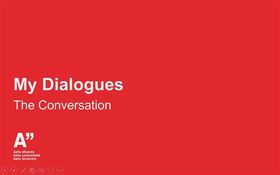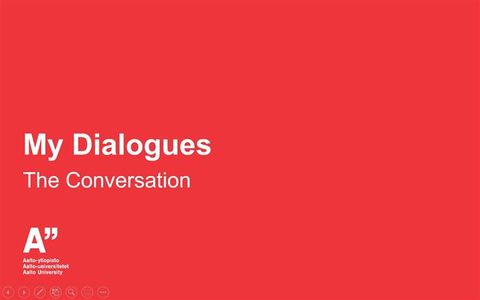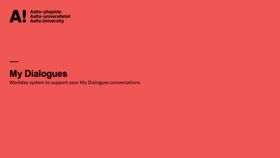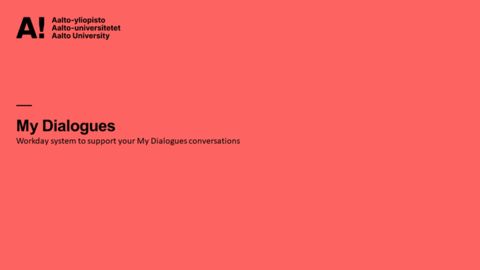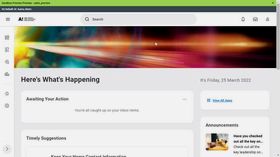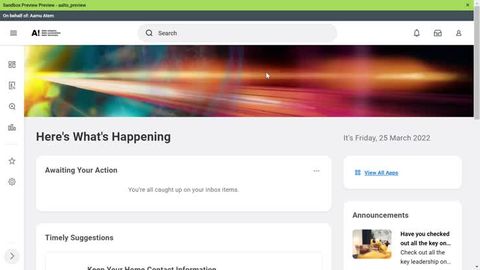My Dialogues
At Aalto, My Dialogues is about having a 1-1 conversation with your supervisor, or a 3-way conversation with your direct and matrix supervisors, twice per year (spring and autumn) about these 3 topics – wellbeing, development and goals.
You can utilise the Workday system to help you set work and personal development goals, make notes and attach documents you want to discuss, and give and ask for feedback from colleagues.
How to have your My Dialogues?
These videos show you some tips on how to have a My Dialogues conversation and how to use Workday.
My Dialogues - preparing
"How to have a My Dialogues conversation"
- explains what is "My Dialogues" (0:21-0:56),
- what are the minimum expectations for My Dialogues at Aalto (0:56-1:59), how you can go beyond those minimum expectations (2:00-3:35), and
- then shows you how to talk about work wellbeing (3:38-5:41), personal development (5:42-6:59), and goals (7:00-11:10).
Sharing feedback is essential in helping individuals and teams improve and grow. Providing positive (I like) and constructive (I wish) comments or input on performance, behavior or work, allows individuals to identify their strengths, areas for development, and opportunities for improvement. Effective communication, collaboration, and continuous learning are fostered through feedback, leading to personal and professional development, enhanced performance and collective success. Without feedback, assumptions and misalignment can occur within a team, hindering progress and wellbeing.
To support you own and colleagues development, you can utilize our supportive structure for feedback, such as feedback giving or asking at Workday or facilitated feedback sessions. Open communication is crucial in teams to foster creativity and handle differing viewpoints while maintaining a safe and productive atmosphere.
For some of you at Aalto, you have a direct supervisor and a "matrix" supervisor. If this is you, we recommend also having a 30-60min 3-way My Dialogues discussion to ensure you and your supervisors are on the same page about your goals, priorities and what's expected of you in your role.
"The three way discussions were much better than the earlier separate ones. There is a lot of value in hearing the two different viewpoints from the two supervisors, and we actually noticed that the priorities seemed to be same from the dean’s and my side. If there were any differences of opinion about the priorities, I think this is a great way to discuss and resolve them openly (rather than put the subordinate between a rock and a hard place to try to figure what the priorities as)" says Marianna Bom, Chief Financial Officer. So, warmly recommended
Prepare
- Draft your goals and priorities for the next 6-12 months. The question guide attached on the My Dialogues aalto.fi page can help you think about what to discuss
- If you don't already meet with each supervisor on a regular basis, schedule a shorter 60- 90min My Dialogues discussion with each supervisor separately for the opportunity to discuss relevant topics in more depth
Tips for Supervisors
- If you don't have regular contact with the other supervisor, organise a short call with them before the 3-way discussion to ensure you're aligned on general work expectations. This ensures less confusion over expectations and priorities in the meeting for the person you supervise
- Who is responsible for initiating a My Dialogue? Me or my supervisor? Typically your supervisor is the one responsible for initiating a My Dialogues discussion by scheduling it. This is partly because your supervisor needs to have their My Dialogue with their own supervisor first to discuss the broader goals for your area before they are ready for their discussion with you.
- What if I have 2 supervisors – a direct and matrix supervisor? We recommend having a 30-60min 3-way My Dialogues discussion with both together to ensure you are all on the same page about your goals, priorities and what's expected of you in your role. Prepare! Draft your goals and priorities for the next 6-12 months before the conversation. We recommend your two supervisors contact each other beforehand to align on your work expectations
- What if my supervisor is not the right person to discuss all aspects of my work with? Sometimes for academics, your direct supervisor in the organisational hierarchy may not be the most appropriate person to give you feedback and guidance on all of your goals. For example, for program directors your supervisor can support with teaching/research goals, but not curriculum development. You can simply contact a person who you feel is appropriate to discuss the other aspects of your work plan with, or your supervisor/HR can help you to identify additional options for feedback, mentoring and coaching.
- How do I talk about salary? This is different for different roles across Aalto, so please talk to your local HR person to find out more.
- What’s the best flow for doing my My Dialogues? Schedule the conversation in the calendar for spring and autumn. Prepare for the conversation by reflecting on the work wellbeing, development and goals questions in the question guide attached on the My Dialogues aalto.fi page. Then in Workday, draft some work and development goals, set some 1-1 discussion topics, attach any documents you wish to discuss, then request feedback from your colleagues. Have the discussion, starting with work wellbeing, then moving into development and finishing with goal setting and your work plan. Finalise anything needed in Workday.
- What’s the difference between goals and development items? For me, some are the same. Goals and development goals are both goals but with different purposes. Goals refers to what you plan to achieve in the different areas of your job, while development goals typically refers to the skills or ways of working that you plan to improve to achieve your work goals more effectively. At Workday you just a place to record these both as a goals.
- Can I edit my goals after submitting them? Yes and we encourage this! Some like to use Workday as their ongoing planning tool and return to Workday to update their goals regularly. For example milestones functionality supports this.
- Can I use Workday on my mobile phone for My Dialogue? Yes. The Workday mobile application is great for viewing goals, development items and feedback. We recommend using a computer for editing goals and development items as the user experience is much better.
- Can I archive feedback? Unfortunately this feature is still yet to be developed by Workday.
- How do I attach relevant documents related to My Dialogues in Workday? You can add link for example to sharepoint or google drive when documenting your goals. Adding attachments can be done through a check-in with someone through the “My 1-1 Discussion Notes & Attachments” feature.
- What is goal cascading and who does it? Goal “cascading” is just another term for a supervisor adding one of their goals to a team member’s goals. Depending on your role, supervisors might cascade Aalto priority goals, school, department, unit or team goals to you for you to incorporate into your work planning.
-
Who can see my My Dialogues information in Workday?
Direct supervisor Matrix supervisor Management chain above Dean Local HR HR Admins Goals x x x x x x Feedback x x x 1-1 discussion notes & attachments You and the person you have created the check-in with x
My Dialogue for Academics – Goals and Workplan
The work plan is an essential part of teaching and research personnel planning their work under the total-working-hours system (excluding master and bachelor students). It improves work planning and allocation of resources by promoting goal setting and their follow-up, and is a concrete tool for allocating working time for the coming academic year. This page includes information on what work plan is, why we need to do it, and how it is done in the Workday system.
The work plan is an important tool in planning the work of the teaching and research staff under the the total-working-hours system. The work plan is primarily an agreement of how you will use your working time. The collective agreement requires that each employee under the total-working-hours system draw up a work plan before the start of the academic year.
The work plan is also an important tool in self-management. It allows you to plan in advance how to allocate your work time into different goals and tasks, and which goals and tasks will not fit into your work plan for the coming academic year. By planning your own work in advance and actively discussing it with your supervisor, you can help keep your workload reasonable and realistic, helping you cope better with your work.
Alongside development and wellbeing, in the My Dialogue discussion the supervisor and the employee agree together on what goals and tasks the employee will have in the coming academic year. When determining these goals and tasks, the allocation of total working hours toward them is reviewed, where the working time allocated must not exceed the employee's total working hours. When considering how your work time should be allocated, use the categories below as a guide. You can choose these categories when creating your work plan goals in the Workday system.
How to fill in the fields for your work plan:
- Goal: Write here your goal
- Description: In this field, you should describe the goals and objectives of that area in more detail so that you can better understand and plan your work as a whole.
- Gategory: Select the correct category from the drop-down menu (i.e. the work category, i.e. 1a=teaching, 1b=supervising, 1c=other duties related to teaching, 2=research and artistic work, 3=impact and service. See the table below for more details.
- Move to the Additional Information sheet, and add Weight: Here you should write the percentage of your working time that you will spend on that goal / task.
- Milestones: If you wish, you could divide the goal/tasks into smaller milestones.
| Category | Tasks included in the category | Workday tips |
|---|---|---|
| 1a Teaching |
Task and goals related to:
|
Write Teaching as a Goal. → Divide the goal into smaller tasks by marking each course separately in the "Milestones" section. |
| 1b Supervising |
Task and goals related to:
|
Write Supervising as a Goal → If you like, divide the goal into smaller tasks, for example by marking the students to be supervised or different task types in the "Milestones" section. |
| 1c Other duties related to teaching |
Task and goals related to:
|
Write Other duties related to teaching as a Goal. → If you like, divide the goal into smaller tasks, for example by marking different task types (see example at the left-hand column) in the "Milestones" section. |
| 2 Research and artistic work |
Task and goals related to:
|
Write Research and artistic work as a goal. → If you like, divide the goal into smaller tasks, for example by marking different task types in the "Milestones" section. |
| 3 Impact and service |
Task and goals related to:
|
Write Impact and service as a goal. → If you like, divide the goal into smaller tasks, for example by marking different task types (see example at the left-hand column) in the "Milestones" section. |
- An indicative work time allocation for tenure track professors can be found here under the subtitle Professor's work profile.
- An indicative work time allocation for lecturers can be found here under the heading Lecturers' work profile.
- For other academic positions, the work time allocation is specified in Other Academic Positions Policies and Procedures -document.
- Most of the working time of postdoctoral researchers is devoted to research and / or artistic work. The work time allocation of Assistant Professor, term 1, can be considered as an indicative rule.
- For academic positions other than those mentioned above, the work profile will be defined to meet the strategic needs of the school and the hiring unit. In Professor of Practice and Adjunct Professor positions focus on teaching.
Performance is all about wellbeing
Wellbeing is a core variable to our success at work and Aalto considers it a key priority. We all have days we’re motivated, focused, and achieving. We also all have days where we’re demotivated, our thoughts are scattered and we’re not okay.
And that’s okay! Acknowledging “I’m not sure whether I’m okay today” is nothing to be ashamed or embarrassed about, especially during these times, and there are a lot of things we can do about it.
One easy, concrete way is to talk about it. When?
- Your My Dialogue is a core, concrete opportunity to discuss wellbeing in depth with your supervisor
- Add wellbeing to your regular one-to-one meetings
- Check in with your colleagues during lunch and coffee catch ups
- Create a wellbeing agenda item in your team meetings.
Here are some questions to consider that could help you reflect on wellbeing and talk about it with others:
Engagement
- How do you feel at work?
- What motivates/demotivates you at work?
Wellbeing
- How do you feel about your workload and work-life balance?
- What do you predict your work wellbeing to be like in the near future?
- How is your experience working in a hybrid way and what are your preferences in the future?
- When are you planning to take time off?
Relationships & Team Culture
- What has the team culture been like recently?
- How are your relationships with your team members recently?
Do something about it! Develop some clear actions to improve wellbeing. For example:
- My Hour – Time for wellbeing | Aalto University
- Shorter meetings and more breaks than before | Aalto University
- Schedules for Classes for University Staff and "Carefree Shoulders" Break Exercises | Aalto University
On top of speaking with your local HR person, Aalto has many guides, tools and ways of supporting you and your team to improve wellbeing.
Investing in your development
We all know how important it is to continue learning, to stay on the cutting edge of practice in your field, while remaining innovative and effective in your approach to your work. But how to balance it while maintaining your work-life balance?
The first step? Talk about it.
Get clear on what it is you want or need to learn to enhance your performance and grow in your role and career. This provides crucial focus which helps you to say no to the areas that are less of a priority for you. But when?
- Your My Dialogue is a core, concrete opportunity to discuss your development in depth with your supervisor and create and/or review your development plan
- Add development-like topics like innovation, continuous improvement, and feedback to your regular one-to-one meetings
- Create a development-like agenda item in your team meetings.
Here are some questions to consider when planning your development:
Strenghts
- What have you learned about yourself since the last discussion?
- What are your strengths?
Role-specific Development
- Which competencies would help you succeed further in your current role?
Career Progression
- What do you want to do in 1-3 years?
- What do you need to get there?
- Which strengths could you utilise more?
A lot of our service personnel use Aalto’s Future Competencies to help evaluate their strengths and weaknesses. For our academics, it’s worth familiarising yourselves with the relevant professor tenure track or lecturer career system pages.
In Aalto we use the 70-20-10 model for learning which suggests that people are always learning, mostly by doing and experiencing on-the-job (70%), and from others (20%).
So, look for opportunities to use the skill you’re trying to develop, watch someone who is good at it and experiment to find what works for you. Ask for feedback from your colleagues, ask your colleagues if they’d like to meet and share their tips and experience on a topic, or identify someone who might be able to mentor you through something.
Have you utilized Aalto University´s coaching servicesalready?
Coaching is a collaborative process in which coaches help participants to develop in terms of personal and professional potential, as well as to clarify ways of improving self-leadership.
Aalto also offers wide variety of trainings to support your development:
- Workday Learning hosts hundreds of free courses on various topics, typically developed by Aalto people, for Aalto people.
- Lifewide Learning at Aalto brings together an extensive and versatile portfolio from courses and programs to online learning offerings
- Keep an eye out for emails from your HR Partners about the latest staff training offerings
